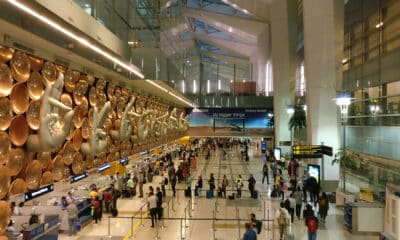News
Monsoon Brings Airport Mishaps: Who is to Blame?
The monsoon has brought not only heavy rains but also a series of unfortunate incidents at airports across India. These mishaps, primarily caused by the relentless downpour, have raised serious concerns about the safety and structural integrity of airport facilities. The most alarming incident occurred at Delhi’s Indira Gandhi International (IGI) Airport, leading to tragic consequences and leaving many questioning the accountability of the involved authorities.
Delhi Airport Roof Collapse: A Fatal Tragedy
Early Friday morning, the canopy at the forecourt of Terminal 1 at IGI Airport collapsed under the weight of incessant rainfall, resulting in the death of Ramesh Kumar, a cab driver, and injuries to eight others. The structure, erected in 2008-09, could not withstand the heavy downpour, leading to this tragic accident. Eyewitnesses reported that around 100 people were present at the spot when the incident occurred, and a greater tragedy was averted only because the canopy tilted before completely collapsing, allowing most people to escape.
The Delhi International Airport Ltd (DIAL) has formed a technical committee to investigate the incident. The police have registered a case under IPC Sections 304A (causing death by negligence) and 337 (causing hurt by an act endangering life or personal safety of others). DIAL, in its statement, attributed the collapse to the continuous heavy rain over a few hours. As a precaution, all flight operations from Terminal 1 have been suspended, with flights rescheduled to operate from Terminals 2 and 3.
🚨Horrendous Visuals.
-Do u feel safe anywere?
-Nobody knows,If a part of a Flyover, Roof or even road you are driving can cave in anytime.
-A roof collapsed at IGI Terminal 1 of Delhi airport resulted in one death & five injuries.
INDIAN LIVES ARE SO CHEAP.😭#DelhiAirport… pic.twitter.com/9XSNZIW6di
— Manu🇮🇳🇮🇳 (@mshahi0024) June 28, 2024
Read More: Delhi Airport Roof Collapse: 1 Killed, 5 Injured; Flight Operations Severely Hit at Terminal-1
Jabalpur Airport: A Close Call
In a similar incident, a portion of the canopy at the new terminal building of Jabalpur airport in Madhya Pradesh collapsed due to heavy rainfall, damaging a car belonging to an Income Tax official. Fortunately, no one was injured as the driver had left the vehicle before the collapse. The Airports Authority of India (AAI) has launched an investigation into the incident, emphasizing that the newly constructed building experienced its first rain, which led to water accumulation and the subsequent collapse of the canopy.
The state Public Works Minister Rakesh Singh assured that measures would be taken to prevent such incidents in the future. The AAI’s statement highlighted the need to investigate the technical reasons behind the incident to ensure it does not recur. This mishap has overshadowed the recent announcement of renaming the airport after Queen Rani Durgavati, and the focus has shifted to ensuring the safety and structural integrity of the airport facilities.
●नाम – जबलपुर एयरपोर्ट
●लागत – 450 करोड़
●उद्घाटनकर्ता- नरेंद्र मोदी
●उद्घाटन तारीख -10 मार्च, 2024 (3माह)
●वर्तमान स्थिति – पहली बारिश में छत क्षतिग्रस्त
●गिरने का कारण -भ्रष्टाचार (निर्माण कार्य में लापरवाही)#JabalpurAirport pic.twitter.com/IBm2M7TWHr— Hansraj Meena (@HansrajMeena) June 28, 2024
Rajkot Airport: Yet Another Collapse
Adding to the series of unfortunate events, the canopy outside Rajkot airport’s passenger pickup and drop area in Gujarat collapsed amid heavy rain. Although there were no injuries reported, the incident underscores the urgent need for assessing the structural integrity of airport facilities during the monsoon season. The collapse at Rajkot airport occurred just a day after the tragic incident at Delhi T-1, raising further concerns about the safety measures in place at airports across the country.
VIDEO | Canopy collapses at the passenger pickup and drop area outside #Rajkot airport terminal amid heavy rains.
(Source: Third Party) pic.twitter.com/gsurfX2O1S
— Press Trust of India (@PTI_News) June 29, 2024
Who is to Blame?
These incidents have sparked a debate on the accountability of the involved authorities. The primary question is whether the structures at these airports were adequately designed and maintained to withstand heavy rainfall. The investigation reports from DIAL, AAI, and other relevant authorities will be crucial in determining the root causes of these collapses.
The Need for Stringent Safety Measures
The recurrence of such incidents highlights the pressing need for stringent safety measures and regular maintenance checks at airports. While natural calamities like heavy rainfall can pose significant challenges, it is imperative that airport infrastructure is resilient enough to withstand such conditions. The incidents at IGI, Jabalpur, and Rajkot airports serve as stark reminders of the potential risks associated with inadequate structural integrity and the importance of proactive measures to ensure the safety of passengers and airport personnel.
As the investigations proceed, it is essential for the authorities to address any lapses in safety standards and take corrective actions to prevent such incidents in the future. The safety of airport infrastructure should be paramount, especially during the monsoon season when the risk of such mishaps is heightened.



































